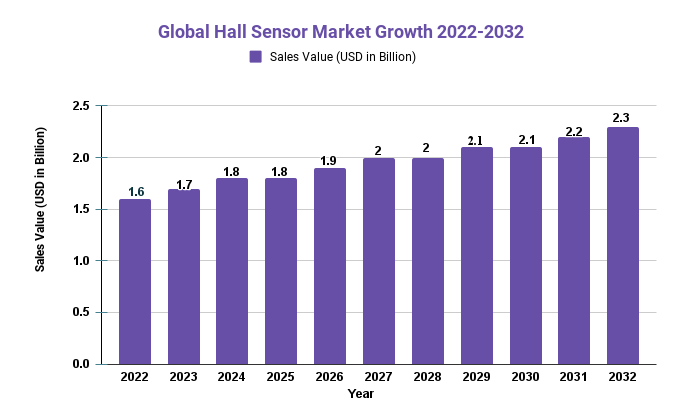Hall Sensor Market Size will Observe Substantial Growth by 2032 with a CAGR of 3.07%

Page Contents
Market Overview
Published Via 11Press: Hall Sensor Market is expected to increase from USD 1.6 billion in 2022 to USD 2.3 billion by 2032, expanding at a compound annual growth rate (CAGR) of 3.07% during the forecast period.
The market growth is primarily fueled by increasing demand for Hall sensors in the automotive sector. These sensors have become increasingly popular over recent years due to their precision readings of speed and position, among other things. Furthermore, with more electric and hybrid vehicles on the road, demand for Hall sensors is expected to surge significantly as well.
In addition, consumer electronics is another major driver for the Hall sensor market. Over recent years, demand for smartphones, tablets, laptops, and other electronic devices has skyrocketed. These products use Hall sensors in a variety of applications like compasses, motion sensors, and touchless switches, among others.
The industrial segment is expected to contribute significantly to market growth. Hall sensors are increasingly being employed in industrial automation and control systems due to their precision at measuring and monitoring various parameters.

Drivers, trends, and challenges have an impact on market dynamics, which can impact businesses. Request for PDF sample report
Key Takeaways
- The global Hall sensor market is expected to experience significant growth over the coming years due to rising demand from the automotive, consumer electronics, industrial, and medical sectors.
- Hall sensors are widely used in the automotive sector due to their accuracy in reading vehicle speed and position.
- Consumer electronics is another major application area for Hall sensors, with rising demand for smartphones, tablets, laptops, and other electronic devices.
- The industrial segment is expected to contribute substantially to market expansion due to the increasing adoption of Hall sensors in automation and control systems.
- Asia Pacific is expected to be the leading market for Hall sensors due to the region's expanding automotive and consumer electronics industries.
Regional Outlook
- Asia Pacific is expected to be the leading market for Hall sensors due to the region's rapidly developing automotive and consumer electronics industries. China in particular will lead this charge due to its expansive automotive and consumer electronics industries.
- Japan and South Korea are also significant markets due to the abundance of electronics manufacturers.
- North America ranks as the second-largest market for Hall sensors due to its abundance of automobile and electronics firms.
- The United States leads the region's Hall sensor market due to its robust automotive and consumer electronics industries.
Drivers
- Growing Demand from the Automotive Sector: The automotive sector is a significant driver of the Hall sensor market, driven mainly by an increase in electric and hybrid vehicles that require accurate speed and position measurements that can be provided by Hall sensors.
- Hall Sensors' Growing Popularity in Consumer Electronics: Hall sensors are finding greater application in smartphones, tablets, and laptops alike due to their precision measurements and control capabilities. Hall sensors offer various benefits in these applications such as touchless switches and motion sensors that require high-accuracy measurements and control.
- Industrial Automation and Control Systems: Hall sensors are becoming more widely used in industrial automation and control systems due to their ability to accurately measure and monitor various parameters. This has driven market growth as industrial automation becomes more prevalent across various industries.
- Miniaturization and Integration: Hall sensors are becoming smaller in size and more integrated into electronic devices, spurring their adoption across a variety of applications. Additionally, this trend is fueling market growth as consumers demand compact and integrated devices.
Restraints
- Price Sensitivity: The Hall sensor market is highly price sensitive, which could pose a significant barrier to growth. Customers tend to seek low-cost items which could restrict market expansion, particularly in developing regions.
- Competition from Alternative Technologies: While other technologies exist that offer similar functions as Hall sensors, their adoption may be limited due to competition from alternative sources. For instance, optical sensors can also measure position and speed in some applications.
- Technological Limitations: Hall sensors have some technological limitations, such as their sensitivity to temperature and magnetic field interference that may reduce their accuracy in certain applications. This could also act as a hindrance to market growth.
- Economic Slowdown: Economic slowdowns can have a substantial impact on the Hall sensor market, as they reduce demand from various industries such as automotive and industrial automation. This may restrict market expansion during times of economic uncertainty.
Opportunities
- Emerging Applications: The Hall sensor market is expected to witness growth in emerging applications such as virtual/augmented reality devices, drones, and autonomous vehicles that require high-precision sensors – something Hall sensors can offer.
- Advancements in Technology: Developments in Hall sensor technology, such as the creation of new materials and integration of multiple sensors into one device, could present opportunities for market expansion.
- Increased Adoption of IoT: The growing adoption of the Internet of Things (IoT) presents opportunities for the Hall sensor market. IoT devices require sensors for various applications, such as temperature and motion sensing, which can be provided by Hall sensors.
- Demand for Smart Sensors: As the demand for intelligent sensors that provide real-time data and can be integrated into various applications grows, this could present opportunities in the Hall sensor market.
Challenges
- Environmental Regulations: The Hall sensor market is subject to various environmental regulations, such as the Restriction of Hazardous Substances (RoHS) directive that limits certain materials' usage. This can increase manufacturing costs and restrict market expansion.
- Competition: The Hall sensor market is highly competitive, with numerous companies offering similar products. This can restrict market growth and reduce profit margins for firms.
- Technical Challenges: Hall sensors face technical obstacles during the design and production process, such as achieving high accuracy and sensitivity in different environments. These obstacles could hinder market expansion.
- Intellectual Property Rights: The Hall sensor market is subject to various intellectual property rights such as patents and trademarks, which could restrict market growth and raise production costs for companies.
Recent Developments
- In March 2021, Infineon Technologies AG launched a new Hall sensor product line for automotive and industrial applications, providing high accuracy, high-temperature stability, and low power consumption.
- In February 2021, Allegro MicroSystems LLC announced the launch of a new family of Hall sensor ICs for high-speed applications, providing high accuracy and high sensitivity.
- In December 2020, TDK Corporation announced the launch of a new range of high-accuracy Hall sensors for automotive applications, providing high sensitivity and low power consumption.
- In October 2020, Honeywell International Inc. announced the launch of a new range of Hall effect sensors for industrial applications, providing high sensitivity and temperature stability.
Key Market Segments
Type
- Analog Output Hall Sensor
- Digital Output Hall Sensor
Application
- Wireless & Consumer
- Industrial
- Automotive
Key Market Players
- AKM
- Allegro
- Infineon
- Micronas
- Melexis
- Ams
- Diodes
- Littelfuse?Hamlin?
- TT Electronics
- Honeywell
- Texas Instruments
- Analog Devices
- MagnaChip
- CHERRY(ZF)
- Bei Sensors
- Vishay
- ROHM
- Toshiba
- Nicera
- Standex-Meder
Report Scope
| Report Attribute | Details |
| The market size value in 2022 | USD 1.6 Bn |
| Revenue forecast by 2032 | USD 2.3 Bn |
| Growth Rate | CAGR Of 3.07% |
| Regions Covered | North America, Europe, Asia Pacific, Latin America, and Middle East & Africa, and Rest of the World |
| Historical Years | 2017-2022 |
| Base Year | 2022 |
| Estimated Year | 2023 |
| Short-Term Projection Year | 2028 |
| Long-Term Projected Year | 2032 |
Frequently Asked Questions
Q1. What is a Hall sensor?
A1. A Hall sensor is a type of magnetic sensor that measures the strength and direction of a magnetic field.
Q2. What are the applications of Hall sensors?
A2. Hall sensors are used in various applications, including automotive speed and position sensing, electronic compasses, motion detection, and industrial automation.
Q3. What are the advantages of Hall sensors?
A3. Hall sensors offer high accuracy, sensitivity, and stability in measuring magnetic fields. They are also small in size and have low power consumption.
Q4. What are the challenges associated with Hall sensors?
A4. Some of the challenges associated with Hall sensors include their sensitivity to temperature and magnetic field interference, technical design and manufacturing challenges, and intellectual property rights.
Q5. What is the future outlook for the Hall sensor market?
A5. The Hall sensor market is expected to grow significantly in the coming years due to increasing demand from the automotive, consumer electronics, industrial, and medical sectors, as well as advancements in technology and emerging applications.
The team behind market.us, marketresearch.biz, market.biz and more. Our purpose is to keep our customers ahead of the game with regard to the markets. They may fluctuate up or down, but we will help you to stay ahead of the curve in these market fluctuations. Our consistent growth and ability to deliver in-depth analyses and market insight has engaged genuine market players. They have faith in us to offer the data and information they require to make balanced and decisive marketing decisions.



